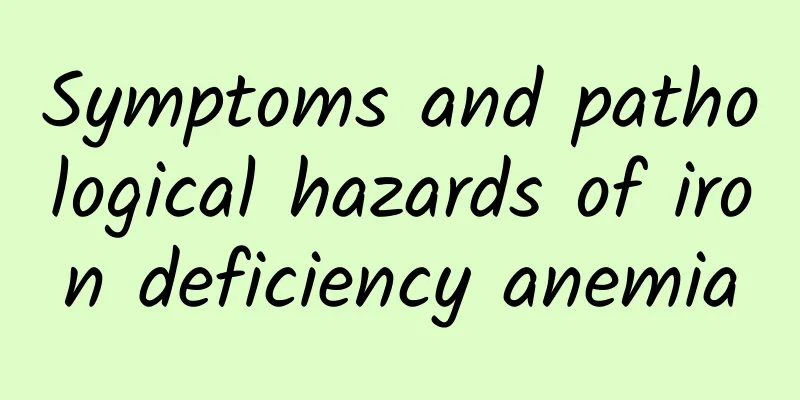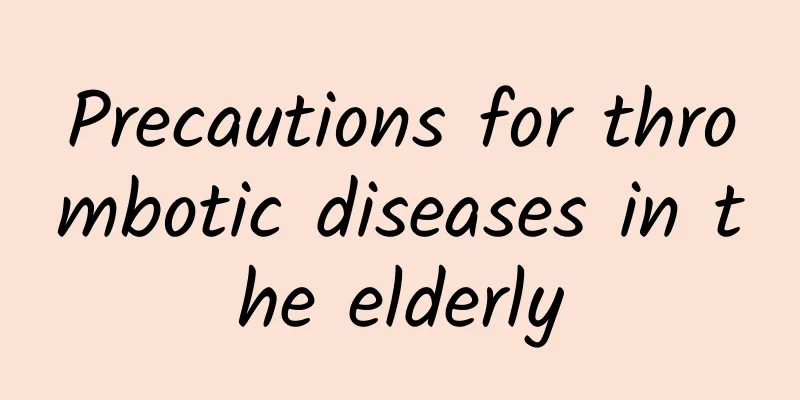Symptoms and pathological hazards of iron deficiency anemia

|
There are many types of anemia, and iron deficiency anemia is the most common. 90% of the anemia we mention in daily life is iron deficiency anemia. So what are the pathological process and symptoms of iron deficiency anemia? 1. The pathophysiological process of iron deficiency anemia includes three stages: (1) Iron depletion (ID): During this stage, the body's iron reserves have decreased, but the iron available for red blood cells to synthesize hemoglobin has not yet decreased. (2) Iron deficiency period of erythropoiesis (IDE): During this period, the stored iron is further depleted and the iron required for erythropoiesis is also insufficient, but the amount of hemoglobin in the circulation has not yet decreased. (3) Iron deficiency anemia (IDA): During this stage, microcytic hypochromic anemia and some non-hematopoietic system symptoms appear. 2. Clinical manifestations The disease can occur at any age, but is most common between 6 months and 2 years old. The onset is slow and the time of onset is often uncertain. Many children are diagnosed with the disease when they seek medical treatment for other diseases. The clinical manifestations vary depending on the severity of the disease. (1) General manifestations: The skin and mucous membranes gradually become pale, most obviously on the lips, oral mucosa and nail beds. Easy to get tired and weak, not active. Older children may complain of dizziness, black spots in front of their eyes, tinnitus, etc. (2) Extramedullary hematopoiesis: Due to the extramedullary hematopoietic reaction, the liver and spleen may be slightly enlarged. The younger the age, the longer the course of disease, and the more severe the anemia, the more obvious the enlargement of the liver and spleen. (3) Non-hematopoietic system symptoms 1) Digestive system symptoms: loss of appetite. A few people may have pica, such as eating soil, wall paint, coal slag, etc. There may be vomiting and diarrhea. Stomatitis, glossitis, or atrophy of the lingual papillae may occur. In severe cases, atrophic gastritis or malabsorption syndrome may occur. 2) Neurological symptoms: manifested as irritability or listlessness. Older children often have difficulty concentrating, memory loss, and their intelligence is often lower than that of children of the same age. 3) Symptoms of the cardiovascular system: When anemia is obvious, the heart rate increases. In severe cases, the heart enlarges and even heart failure may occur. 4) Other manifestations: Due to low cellular immune function, infection is often present. Fingernails and toenails may develop ingrown toenails due to abnormal epithelial tissue. |
<<: Why are my fingers numb? How to treat numb fingers
>>: What is the cause of infertility during ovulation?
Recommend
What to do if your tongue ulcers occur during lactation
Breastfeeding is a stage in which every woman mus...
What fruits are good for skin allergies? Which fruits are good for the skin?
Sometimes, skin allergies are closely related to ...
How to take Huoxiang Zhengqi Pills
How to take Huoxiang Zhengqi Drops? When seeing t...
The anus is swollen and there is a meat ball
Chrysanthemum is an elegant name for the anus. Th...
Why do pregnant women have swollen feet? Let's learn about the causes and relief methods of swollen feet in pregnant women
After pregnancy, as the months go by, a woman'...
What foods stimulate stomach acid?
Eating food at the wrong time can cause stomach a...
What to do if your toenails are black?
The phenomenon of blackened nails is very common ...
Natural gas poisoning symptoms
Because the use of natural gas has brought great ...
What antibiotics are used for staphylococci?
Staphylococci can cause staphylococcal infections...
TCM Methods for Treating High Blood Sugar
High blood sugar is a common disease. If you have...
Why do my calves feel sore and swollen every night when I go to bed?
In daily life, if you always feel soreness and sw...
What are the effects of aminophylline?
Many people have poor gastrointestinal function a...
The efficacy, effects and contraindications of Sargentoides chinensis
Sarcandra chinensis is a traditional Chinese medi...
Is left ventricular high voltage dangerous?
Studies have found that there are many clinical c...
What should I do if I drink spoiled Chinese medicine?
Chinese medicine can regulate the body and also c...









